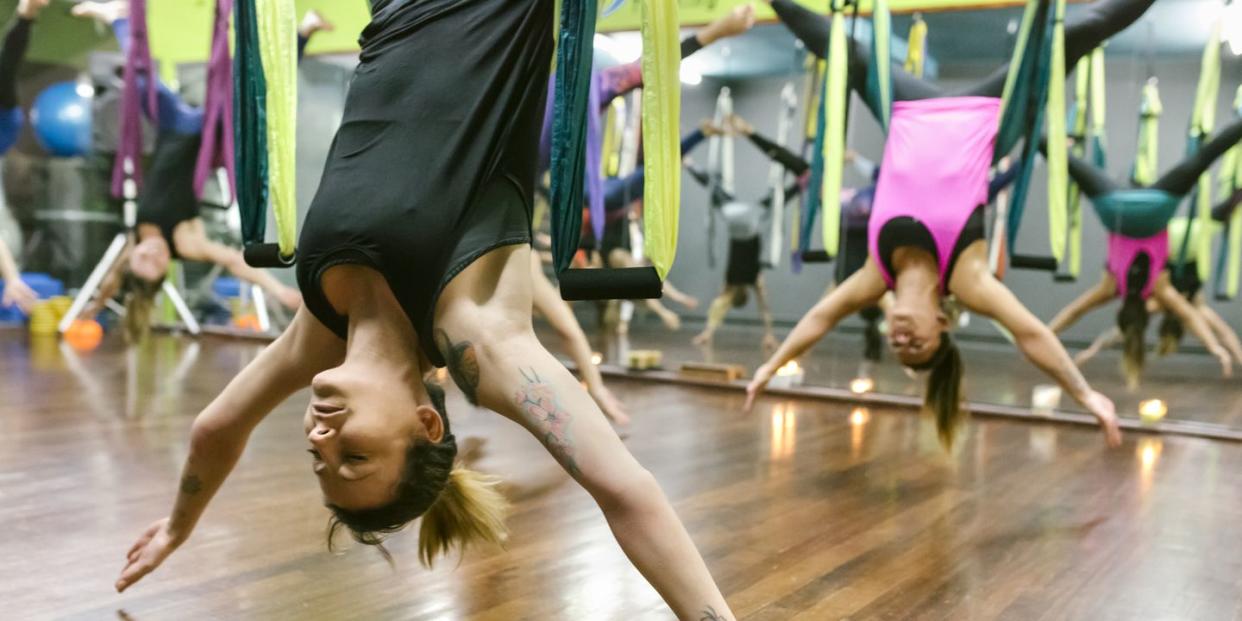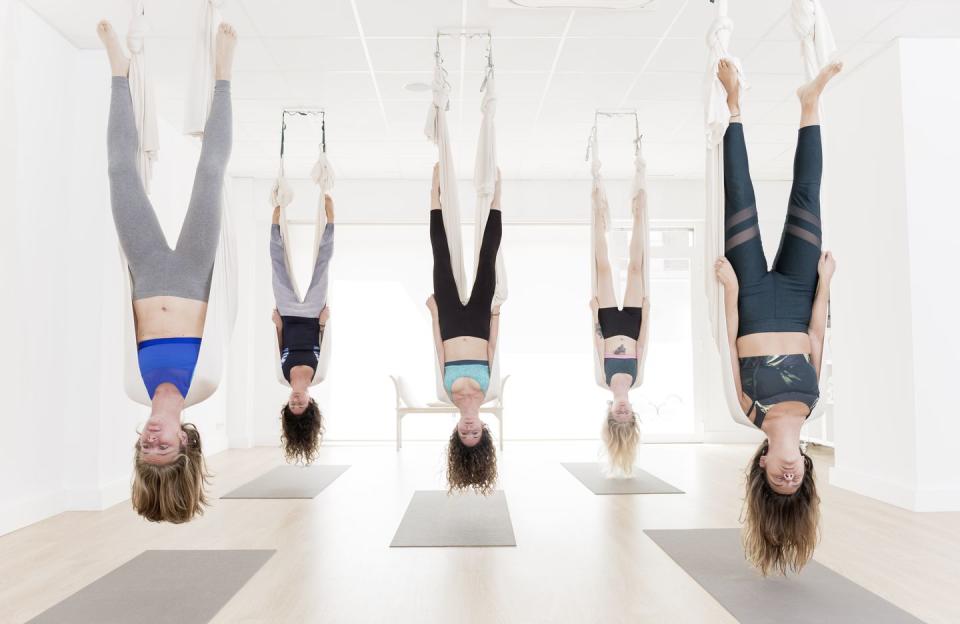Aerial Yoga Can Help You Finally Nail Your Inversions

As a former gymnast, I’ve spent plenty of time hanging out in the air. So, naturally, I’m pretty intrigued by a certain style of yoga: aerial yoga. You too? No acrobatics required on your resume to be curious, or take flight in the practice.
Lots of “yoga and” varieties have come about in the last few decades, according to Kevin Bigger, e-RYT 500, an aerial yoga instructor at Om Factory and a co-creator of Om Factory’s Aerial Yoga Teacher Training Curriculum. (Think: yoga and Pilates, or even yoga and goats!) Aerial yoga is one of those hybrid styles, Bigger says; basically, it combines traditional yoga practice with aerial circus performance.
Meet the expert: Kevin Bigger, is a registered yoga teacher, an aerial yoga instructor at Om Factory, and a co-creator of Om Factory’s aerial yoga teacher training curriculum.
That combination adds up to super impressive pics, yes, but also a solid workout. If you’re anything like me, you’ll be inspired to try some of those poses ASAP. Just make sure to consult a doc before making any lifestyle changes or flipping upside down for an extended sesh.
Trying out this new modality comes with pretty sweet perks, too. Aerial yoga boasts tons of potential benefits, from enhancing a traditional yoga practice to bringing playfulness into your fitness regimen and more. Read on for all the details on those high flying benefits, plus tips to prep your body and mind to make the most of your aerial yoga experience.
What is aerial yoga?
Aerial yoga combines traditional yoga with aerial circus performance. Most aerial yoga studios use aerial hammocks or slings, which are typically hung at hip height above your yoga mat, according to Bigger. You’ll use that hammock for most of what you do during class, Bigger says.
Exactly what you’ll do in class depends on your skill level, and who’s teaching, Bigger says. (More first-timer tips in a sec.) There are plenty of options, from traditional yoga poses with parts of your body touching the hammock (like a lunge with your back foot in the hammock) to aerial conditioning exercises (like core work and pull-ups), according to Bigger. He adds that some teachers even include elements of Pilates and barre in their classes. Make it a routine and you might even get to do some aerial circus moves, like supported flips.
7 Benefits Of Aerial Yoga
Aerial yoga might look and sound like just plain fun, but there's more to the gravity-defying modality. There are tons of potential benefits to practicing aerial yoga, according to Bigger.
It's beginner friendly. Some part of your body is almost always holding onto the hammock, according to Bigger. So, it can be supportive for someone struggling with their balance. That support also makes it approachable for beginners.
It can also challenge (and improve) your balance. “There’s ways in which we can strengthen the muscles of the hips that support balance and strengthen your awareness of where your center line is so that you can balance better,” Bigger says.
It can help you nail new poses. Another major benefit of aerial yoga is that it can help people tackle inversion poses without putting weight on the neck, according to Bigger. Headstands, for instance, are very difficult for people with upper back tension and neck problems, he explains. But the aerial yoga version provides the benefit of spine lengthening without putting weight on your head. “In a classical yoga curriculum, the inverted poses are seen as an integral part of the practice,” Bigger adds. “So [aerial yoga] gives more people an opportunity to get that benefit.”
It can supplement a traditional yoga practice. Aerial yoga trains muscles that you don’t hit in traditional, on-the-ground yoga, per Bigger. In particular, he says that aerial yoga strengthens the muscles in your back body, like your rhomboids, traps, and lats—and the circus movements can engage your hamstrings and glutes.
It can invite playfulness into your workouts. “Yoga can have a tendency to become very serious,” Bigger says. He notes that the rigor and seriousness of the discipline may be off-putting to new students—but the playfulness of aerial yoga may be more appealing.
It creates a community. At some point during class, you’ll probably lightly bump into someone else while you’re moving around on the hammock, Bigger says. That’s not a bad thing! You almost have to acknowledge the other people around you during class, he explains. Aerial yoga, he notes, seems to amplify the community building you might experience in a regular yoga studio.
It can be empowering. “As adults, we often don’t do things anymore that scare us,” Bigger says. “Most people in their first couple of classes experience a pose or two that makes them deal with their fear response.” (Although the instructors do try to make you feel safe during class!) For people who live more timidly, he explains, aerial yoga can be empowering in that it provides a safe environment to face the things that make you uncomfortable.
What To Expect During Aerial Yoga Class

If you’re a newbie like me, no worries. Bigger has plenty of tips to help you prepare for your first flight like an aerial practice pro.
What To Wear To Aerial Yoga
You can walk into your first aerial yoga class looking like a regular. Here's what Bigger recommends wearing to feel comfortable and perform.
Dress in tighter fitting athletic clothing. You’ll probably be more comfortable, Bigger advises. That way, you don’t have to worry about any wardrobe malfunctions (and potentially feeling self-conscious) when you flip upside down.
Cover up with longer pants/sleeves. It’s also a good idea to wear at least capri-length pants (like these bestselling leggings). Shorter shorts can be uncomfortable, Bigger says, because the hammock does get wrapped around the backs of your knees and thighs. (Fabric burn? No thanks!) “Similarly, there are a couple of moments where the hammock will get close to the armpit,” he says. Shirts with sleeves are better than tank tops.
Wear a sports bra. It's not a HIIT class, but don’t forget a good, supportive sports bra. Bigger notes that you’ll want good support while you’re moving around with the hammock.
Leave jewelry at home. As for accessories, best to leave it behind (for the most part). “Jewelry will damage the hammock,” Bigger explains, so don’t be surprised if your instructor asks you to remove it. Your fitness tracker *might* be okay to wear, but some people find them uncomfortable, he adds.
What To Do Before An Aerial Yoga Class
When it comes to physical prep, Bigger recommends coming to class well-hydrated to avoid getting dizzy and woozy. And, don’t arrive with a super full stomach—or an empty one. For example, “if you’re coming for an evening class, make sure you don’t skip lunch,” he adds.
On the mental side, acknowledge that you’re doing something brand new, Bigger advises. Even if you’re a yoga teacher on the mat, he adds, the aerial hammock will change the nature of the poses and might make you feel like you don’t know what you’re doing.
Expect to experience some discomfort during class (and it's okay). For example, the first time you have the hammock wrapped tightly around your body isn't comfortable, Bigger explains. Your teacher should know how to adjust or add padding to the pose to make you comfortable—but you need to ask for a modification, he adds. Don’t be shy!
Finally, you don’t want to be running into your first aerial yoga class right as it’s getting started, Bigger notes. He suggests arriving about 10 minutes early so you can get comfortable in the studio and give your instructor time to adjust the height of your hammock.
What Happens In An Aerial Yoga Class
An aerial yoga class at Om Factory goes something like this: Students are invited into the room when it’s ready. They’ll each place a mat under their hammock, and the instructor will adjust its height accordingly.
Class often begins in a way that’s similar to a typical yoga class: Instructors might choose to start with centering and grounding poses and breathing, or perhaps an opening meditation. Then, the 75-minute class—again, a combination of stretching, strengthening, yoga poses, conditioning, aerial circus, and dance—gets rolling. The exact structure of the class depends on various factors, including teacher preference. For example, Bigger might spend 45 minutes on yoga and dedicate the final half hour to aerial circus. Sometimes he even integrates a moment into class where people can take out their phones and snap a pic of something they’ve learned.
“Usually, class ends with a five-minute or so floating Savasana,” Bigger says, adding that it’s basically like a nap in the hammock. (Count me in!)
How Aerial Yoga Compares To Mat Yoga
You might be wondering how your fave mat yoga class compares to an aerial sesh. The structure may actually feel pretty familiar, according to Bigger—but it’s also going to have some differences.
For example, something that feels like a Sun Salutation, he says, is more of an intermediate level of aerial yoga. So while many Vinyasa yoga classes start with seated meditation, seated stretches, down dog, walk to the top of your mat, Sun Salutation A, you can probably expect a different kind of warm-up in an aerial class.
Where To Find Aerial Yoga Classes
Let me guess: You can't wait to try aerial yoga. (Same, girl.) To help you out, here’s a list of some of the studios around the country that offer aerial yoga classes.
Chicago/Denver/Los Angeles/Phoenix: AIR
Dallas: Blue Feather
Los Angeles: Fly Fit Lenise
New York: Om Factory
New York: Christopher Harrison’s AntiGravity Lab
Orlando: Elevate Yoga Center
Seattle: Flight Room Seattle
You Might Also Like

